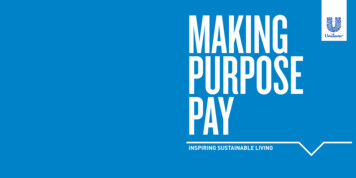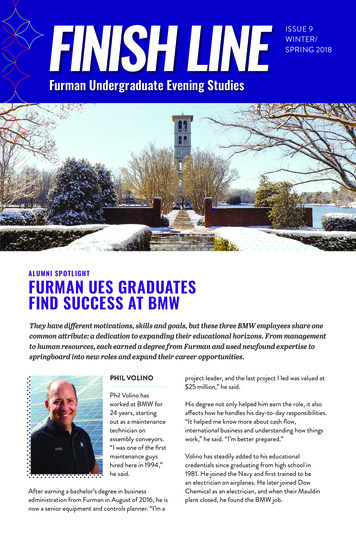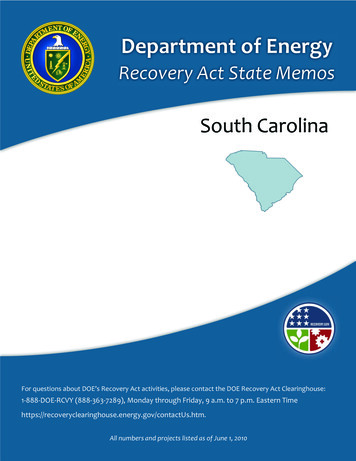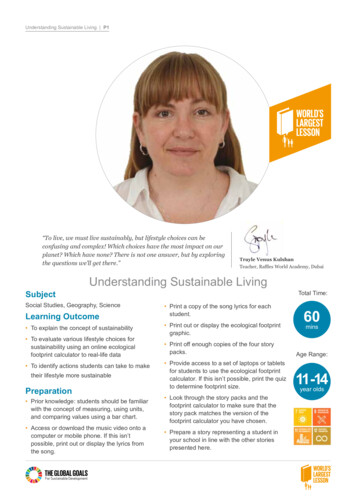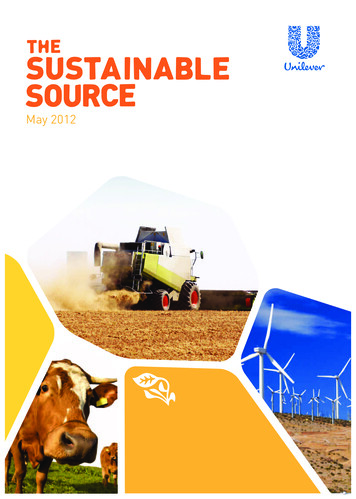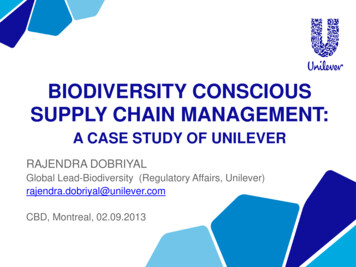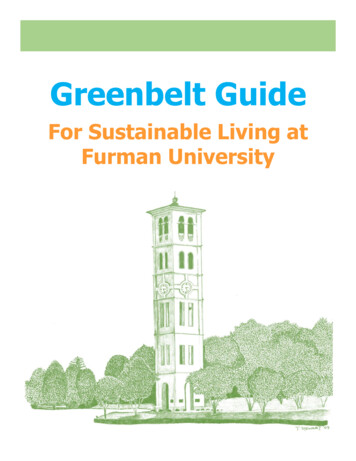
Transcription
Greenbelt GuideFor Sustainable Living atFurman University
Welcome to the Greenbelt!These four cabins are together known as the “Greenbelt” and house 22 students. TheGreenbelt is intended to foster sustainable living and lifestyle choices among itsresidents and to provide a residential community for sustainability minded students tocome together to live, learn, and develop sustainability leadership skills. This livinglearning community is designed to serve as an incubator for the training anddevelopment of sustainability student leaders on campus and in the surroundingGreenville community. Residents will help contribute to campus wide sustainabilityinitiatives and facilitate and contribute to community action through service. Theprimary goal of this community is not only to promote sustainable living, but also toempower students to make a difference in sustainability initiatives at Furman andbeyond.The Greenbelt does not require any previous experience with sustainable living, but awillingness to explore and experiment with being more sustainable in your day to daylife! This guide has been created by past Greenbelters and is intended to provide youtips, resources, and information to help you on your sustainability journey!1
ContentsWater Conservation3Dish Washing4D.I.Y. Cleaning Supplies5Energy Conservation6Recycling7Composting8Waste Reduction9Eating Sustainably/Locally10-11Windowsill Herb Gardens12-13Getting Outdoors in Greenville14Transportation15-16Get Involved17-192
Water Conservation Tips Turn off the water when you are not using it, whether you’re brushingyour teeth, shaving, or washing dishes when you are not rinsing. Reduce the amount of time you are in the shower with the water running.This may mean taking shorter showers or simply turning off the waterwhile you are lathering, washing your hair, or shaving. Reuse water whenever possible: is the water too cold to get in the showeryet? Fill up a cup or bucket with some of the water to water your plants,rather than letting it flow down the drain. Report leaks (in the toilet, sink, washing machines) to Housing (x2092) assoon as you notice them and fill out a maintenance request availablethrough Housing and Residence Life website. Make sure you have a full load of laundry (or combine with a friend)before using the washing machines. Use the “Bright Colors” setting on thewashing machine – it uses cold water, which requires 90% less energy percycle. Don’t buy bottled water, instead use a reusable water bottle and put apitcher of water in the fridge.Leaky faucetsthat drip at therate of one dropper second canwaste up to2,700 gallons ofwater each year.You can saveup to 2 gallonsof water witheach minuteyou shave offyour shower!3
Staying Green While You’reKeeping CleanWashing dishes isn’t fun, but it has to be done. Here’s the mosteco-friendly/efficient way to do it: Use a wash tub or plug the sink Fill the sink/tub with warm, soapy water and use minimal dish soap**Only fill the tub as high as you need to fully submerge a dish. If the wateris too high, every time you dunk a dish you’ll be making a bigger mess.** Place a sponge or dish rag in the sink to get it soapy. Starting with the noneating surface of the least-dirty dishes, use the sponge or rag to scrub theentire dish until it is clean. Dip the dish in the water that is in a separate tub. This way you can rinse thedishes without having to run more water. Continue this method until done, dumping the rinsing tub water andreplacing it whenever its water gets too sudsy. Set each clean dish to the side on a towel or drying rack, and dry withseparate towel once all dishes are clean. For dishes that are too big to rinse in the tub, like pots and pans, rinse withcold water under the faucet being careful not to let the water run longerthan you’re using it.Green cleaningbrands likeSeventhGeneration andMethod areavailable at Publix.4
D.I.Y. Green Cleaning SuppliesAll-purpose cleaner½ cup of white vinegar ½ cup of water 2 tablespoons baking soda 10 drops of tea tree,lavender, or lemonessential oilDissolve and mix Drain Cleaner ½ cup baking soda ¼ cup white vinegarAdd baking soda thenvinegar. Let sit for 1 hourthen pour hot waterdown the drain to rinseClothing Stain Remover 1 part hydrogen peroxide 1 part baking soda 2 parts waterMirror/glass cleaner ¼ cup white vinegar ¼ cup isopropyl alcohol 1 tablespoon cornstarch 2 cups waterShake wellLiquid laundrydetergent ½ cup Borax ½ cup washing soda ½ cup Dawn dish soap 4 cups hot waterCombine first 3ingredients into gallonplastic jug. Pour water todissolveToilet bowl cleaner 1 cup vinegar 1/4 cup baking sodaScrub5
Energy Conservation Tips Instead of turning on lights, use natural daylight when possible. Turn off lights when you leave an area and/or are not using them. In the summer, set the thermostat as high as you can comfortably stand it,and in the winter, set it as low as you can comfortably set it. Items that are plugged in still use energy even when they are poweredoff! So unplug devices that you are not currently using to avoid “phantompower use”! Use LED light bulbs for your desk lamps. Wash clothes on the cold cycle and do only full loads. Dry laundry on a clothesline or drying rack to avoid using the dryer. Reduce hot water usage when taking a shower, doing laundry, or doingthe dishes.LEDs use at least75% less energy,and last 25 timeslonger, thanincandescentlighting.Cooling andheating accountfor roughly 50% ofhome energy use!6
RecyclingHere is what can be recycled on Furman’s campus.Do Recycle (single stream) Plastics #1 & #2 (soda/waterbottles, milk jugs)Aluminum (cans)Tin/Steel (cans)Paper (all kinds and colors)NewspaperMagazinesUncoated CardboardAluminum foil (clean)Small electronics andbatteries (in P2X container inTrone)Do NOT Recycle StyrofoamPlastic bagsCoated cardboardChip bagsCandy wrappersPlastics #3-7GlassLook for thesesymbols on thebottom of plasticcontainers toidentify the typeof plastic.Ways to Reduceand Reuse––––Use water bottlesUse reusable bagsUse scrap paperShop at thrift store7
CompostingIn the United States, food and yard waste is an estimated 20-30 percent ofthe total waste stream. Composting these materials instead of throwingthem away enriches soil, reduces the need for chemical fertilizers, andminimizes waste sent to landfills.What to CompostGreens‣‣‣‣‣‣All fruits and vegetablesCoffee grounds and filtersLeafy plant trimmingsGrass clippingsAnimal WasteMeat and Dairy (ONLY atFurman Farm)Browns‣‣‣‣‣‣EggshellsPaper productsTea BagsDry leavesDryer LintCompostable to-gosMaking Great Compost and Using itEach cabin has a compost bucket that you canfill and then either dump at the Furman Farmor in your rotating compost bin on the backporch. Strive for roughly equal amounts of“greens” and “browns”, and be sure to flip thebin about every 2 weeks. The more you flip it,the faster you will produce compost.The compost can be used as eco-friendlyfertilizer for houseplants or donated to theFurman farm.8
Waste Reduction Buy less stuff! Try to avoid disposable items and items with excessive packaging,and possibly buy in bulk Don’t contaminate recycling bins with trash. Donate to Goodwill when you have items you no longer need,especially upon move out. Buy secondhand furniture, books, and clothing to save moneyand reduce your resource use. Take reusable shopping bags to the grocery and other storeswhen you shop. Edit papers on screen instead of printing. If you print, be sure to print double-sided copies. Carry a refillable water bottle and use the water bottle refillingstations located around campus.The typicalAmericangeneratesabout 4.4pounds oftrash per day!Globally, 22 billionplastic bottles arethrown out eachyear!9
Eating SustainablyHere are some easy tips for eating moresustainably: Eat food. Not too much. Mostly Plants! Avoid processed foods.Eat less and avoid food waste.Eat less meat. Aim for a plant based diet.Eat locally. Buy from local markets. Eat organically. Eat seasonally. Celebrate produce in season!Buy Fair Trade. Look for fair trade items which indicates farmers are paidand treated justly.10
Eating LocallyLocal Farmer’s MarketsTD Saturday MarketMain Street at McBee Ave, Greenville, SC 29601Saturdays, May – October, 8 AM to NoonTravelers Rest Farmers Market115 Wilhelm Winter Street, Travelers Rest, SC 29690Every Saturday, May – September, 8:30 AM to NoonSlow Food Earth MarketAt Swamp Rabbit Café, 205 Cedar Lane RoadFirst and Third ThursdaysMay – November, 3:30 – 7 PMLocal Produce StandsGreenville State Farmers Market1354 Rutherford Rd.Greenville, SC 29609Monday – Saturday, 8 AM–6 PMThe Tomatoe Vine4120 Old Buncombe RdGreenville, SC 29617Year Round Organic MarketRestaurants Featuring Local FoodsRoost220 N. Main St., GreenvilleSwamp Rabbit Café and Grocery205 Cedar Lane Road, GreenvilleBacon Brothers3620 Pelham Road, GreenvilleKitchen Sync1609 Laurens Road, Greenville11
Windowsill Herb GardensFor the plant-loving, overloaded college studentWindow-sill herb gardens are perfect for the plantloving college student because they: Require little maintenance/gardening backgroundSave money and reduce carbon emissions (no need todrive to the grocery store to buy herbs!)Spice up meals with nutritious, organic ingredientsRelieve stress through aromatic therapy (along withthe instant stress-relief that comes from tendingplants)Provide an educational experience, allowing studentsto try different gardening techniques and learn aboutdifferent varieties of herbs and their benefitsFoster a communal sharing of herbs within the cabincommunity12
Window Sill Herb Gardens Assessyour sunlight situation: Most herbs need about 6 or more hours ofsunlight a day. Windows are ideal for indoor gardens. For outdoor gardens, anysurface that is exposed to sunlight will do! Pot:You can put multiple herbs in one pot, as long as each herb has anappropriate amount of space for its roots to develop. Potting soil:You want a potting mix that is made specially for containers, notanything that reads “gardening soil”. Ask for assistance at the store if you’re notsure. Plants: Startingwith seeds requires more attention and increases the chances ofplants dying before they mature. To get results fast with less maintenance, buyseedlings (established toddler herbs and veggies). The farmers market is a greatlocal source to purchase baby plants! Don’tovercrowd your plants: Leave several inches between plants and limit afew plants to each pot. This allows their roots to fully develop and prevents themfrom competing over resources. Makesure pots have drainage holes: This prevents you from drowning yourherbs! Watering: Eachplant has specified watering needs. If plants start to wilt, theyare dehydrated. This may take some trial and error to figure out! Keep your dirthealthy: Try sprinkling some compost over the surface of the soilto enrich its quality. Keep ontrimming: Trim herbs from the top regularly so they continue to grow.Don’t cut leaves from the bottom, this may damage their solar-source!13
Enjoy the Great OutdoorsThe Swamp Rabbit TrailThis 20 mile rail-trail cuts directly through campus. Turn right and you will end upin Travelers Rest; left and you will end up in downtown Greenville!Falls Park - Downtown GreenvilleFalls Park, located in downtown Greenville, is one of the city's great outdoor hotspots. The park serves as an oasis within the city - a place where people gather towork, play, and celebrate. The multi-use park lends itself to a wide variety ofactivities for people of all ages and interests.Paris Mountain State ParkLocated 15 minutes from campus by car, Paris Mountain Park has a lake forswimming and kayaking, picnic areas, campsites, and some great trails for hikingand mountain biking.Jones Gap State ParkLocated 25 minutes from campus by car, Jones Gap is part of the Mountain BridgeWilderness Area, 11,000 acres of pristine mountain woodlands on the Blue RidgeEscarpment. The park offers challenging and scenic hiking with trailside camping.Table Rock State ParkLocated 25 – 30 minutes from campus by car, Table Rock Park features two lakes forswimming and kayaking, a campground, and mountain cabins for rent. The park hasexcellent hiking including a trail that leads to the top of Table Rock which offersspectacular views of the Upstate!Caesars Head State ParkLocated 30 - 40 minutes from campus by car, Caesar’s Head Park has perhaps thebest views of the Upstate. Large rock outcrops atop the dramatic Blue Ridgeescarpment offer breathtaking views year round. The fall is a spectacular time tovisit to see the changing colors of the leaves!14
TransportationThe Furman campus is a convenient place to walk and bike.The Swamp Rabbit Trail serves as a great connector for theuniversity community to have safe and easy access to thenearby cities of Travelers Rest and downtown Greenville.If students are not able to bring a bicycle to campus, studentsare able to rent a bicycle from Paladins on Bikes (FUPOB) forthe semester through the Shi Center, borrow a bicycle on anhourly basis from the Physical Activity Center (PAC).Campus Walking MapWALKING &BIKINGFurman provides a variety of alternative transportation options to getaround on and off campus such as bike rental programs, public bus,shuttle services, and a very walkable campus. Avoid using a car!15
TransportationThe Greenlink is Greenville's public transportation systemGREENLINKOperation Hours: - Monday-Friday, 5:30 AM to 7:30 PM- Saturdays from 8:30 AM to 6:30 PM.Bus Stops:-PublixCherrydale Shopping CenterDowntown GreenvilleTransit center (where you canconnect to destinations such asHaywood Mall)- Just outside of Furman's campusmain gate entrance on route 3C.Cost:- One-way ticket: 1.50Website:- http://www.ridegreenlink.com/-The Paladin Trolley- Operation Hours: Fri & Sat evenings, 10 PM to 1:45 AM- Brings students to downtown Greenville- Picks up at North Village J-SafeRide- Operation Hours: 7-days a week, 6:30 PM to 2:00 AM- Will bring students to their desired location across campus- Request Service: 864-772-0007-SGA shuttle- Operation Hours: Week days, 7:30 AM to 11:30 AM and1:00 PM to 5:00 PM- Provides students transportation from North Village to theacademic buildings and the dining hallSHUTTLESFurman offers three different shuttle services to students:16
Get InvolvedThere are a number of campus organizations that work onvarious sustainability issues.Environmental ActionGroup (EAG)Heller Service CorpEAG is a non-partisan groupcommitted to environmentalstewardship, advocacy, andeducation. They focus onpromoting eco-friendly lifestyles,while offering service projectsand activities that support thisphilosophy.Broaden your horizon andtake full advantage of thenumerous opportunities toserve our community! HellerService Corps offersvolunteer opportunities towork with a wide array ofcommunity partners.Furman CreativeCollaborative (FCC)Furman Outdoors Club(FUOC)The FCC is a student-runorganization committed tofostering a creative culture atFurman University. The grouporganizes and presentsTEDxFurmanU each yearamong other events.FUOC creates and supports acommunity of students aimedat experiencing the naturalworld. Exploration. Fear.Triumph. Beauty. If you likethe outdoors, FUOC offersregular expeditions!syncDIN can connect you to student organizations and theirmembers and allow you to explore your communityhttps://furman.campuslabs.com/engage/17
The Shi Center for SustainabilitySince the mid-1990s, sustainability has been a strategic priority for Furmanand has made us distinctive, particularly in the Southeast. Over the lastdecade, the university has been at the cutting edge of sustainability in highereducation at the national level with both the creation of the Shi Center forSustainability and the first, and only, Bachelor of Science degree inSustainability Science at a liberal arts institution in the United States. We havegarnered increasing national recognition for our sustainability efforts includinga STARS Gold rating in 2015 and 2018, and AASHE’s 2009 and 2016 NationalCampus Sustainability Achievement Award.Student Fellows ProgramThe Shi Center hosts a student fellows program. These paidfellowships engage students in sustainability research, service, andinternships around both campus and community based projectswith fellowship offerings during the summer and the academicyear.18
The Furman FarmThe Furman University Farm is a ¼ acre organic practice garden with acomprehensive composting program. The farm is largely student run under thesupervision of Bruce Adams, Furman Farm Manager. It sits on land that used tobe tennis courts behind the Greenbelt Community. Significant attention to soilquality, a French drain system, and endless hours of manual labor havetransformed this area into a highly productive demonstration farm.The farm grows thirty-five different fruits and vegetables and sells its produceto the Furman Dining Hall. It has also supported a Community SupportedAgriculture (CSA) program in the past, in which students, staff, faculty, andcommunity members can purchase a share of the farm.The farm offers paid student positions and always accepts volunteers!19
Community ConservationCorps (CCC)The Community Conservation Corps (CCC), founded in 2009, is a home weatherizationprogram for low-income homeowners in the greater Greenville area. Its mission is toreduce energy consumption, promote the financial stability of homeowners, andincrease environmental awareness. It provides things like attic insulation, air sealing,and HVAC servicing. The Shi Center collects the carbon credits gained from savinghomeowners energy.Students have been integrally involved in the weatherization process. Many Furmanstudents come out to help with tasks including caulking, duct sealing, and changinglight bulbs. The homeowners enjoy hearing stories from students, and vice versa!The Community Conservation Corps is always accepting volunteers!Email: ccc@fuman.edu19
“For over 70 years economics has been fixated on GDP, or nationaloutput, as its primary measure of progress. That fixation has beenused to justify extreme inequalities of income and wealth coupledwith unprecedented destruction of the living world. For the twentyfirst century a far bigger goal is needed: meeting the human rights ofevery person within the means of our life-giving planet.”-Kate Raworth, Doughnut Economics:Seven Ways to Think Like a 21st-Century Economist
Greenbelt is intended to foster sustainable living and lifestyle choices among its residents and to provide a residential community for sustainability minded students to come together to live, learn, and develop sustainability leadership skills. This living learning community

